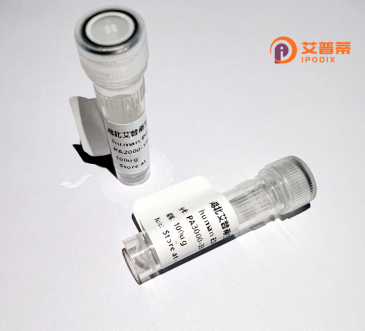
| 纯度 | >90%SDS-PAGE. |
| 种属 | Human |
| 靶点 | ZNF256 |
| Uniprot No | Q9Y2P7 |
| 内毒素 | < 0.01EU/μg |
| 表达宿主 | E.coli |
| 表达区间 | 1-627 aa |
| 活性数据 | MAAAELTAPA QGIVTFEDVA VYFSWKEWGL LDEAQKCLYH DVMLENLTLT TSLGGSGAGD EEAPYQQSTS PQRVSQVRIP KALPSPQKTN PCEICGPVLR QILHLVEHQG THHGQKLYTD GACRKQLQFT AYLHQHQKQH VGQKHFRSNG GRDMFLSSCT FEVSGKPFTC KEVGKDFLVR SRFLQQQAAH TRKKSNRTKS AVAFHSVKNH YNWGECVKAF SYKHVRVQHQ GDLIRERSYM CSECGKSFST SCSLSDHLRV HTSEKPYTCG ECGKSYRQSS SLITHRRIHT GVRPHQCDEC GKLFNRKYDL LIHQRVHTGE RPYKCSECGK SFSHSSSLIT HQRIHTGMRP YECSECGKSF IHSSSLITHQ RVHTGTRPYM CSECGKSFSQ SCHLIKHRRL HIGEGPYECS ECGKLFTYRS RFFQHQRVHT GVRSHECHEC GKLFSRKFDL IVHERVHTGE RPYECSECGK SFTCKSYLIS HWKVHTGARP YECGECGKSF THSSTLLQHQ RVHTGERPYE CNECGKFFSQ SSSLIRHRRS HTGERPYECS ECWKSFSNHS SLVKHRRVHT GERPYECSEC GKSFSQSSNL TNHQRIHSGE RPYECSDCGK FFTFNSNLLK HQNVHKG |
| 分子量 | 71.8 kDa |
| 蛋白标签 | His tag N-Terminus |
| 缓冲液 | PBS, pH7.4, containing 0.01% SKL, 1mM DTT, 5% Trehalose and Proclin300. |
| 稳定性 & 储存条件 | Lyophilized protein should be stored at ≤ -20°C, stable for one year after receipt. Reconstituted protein solution can be stored at 2-8°C for 2-7 days. Aliquots of reconstituted samples are stable at ≤ -20°C for 3 months. |
| 复溶 | Always centrifuge tubes before opening.Do not mix by vortex or pipetting. It is not recommended to reconstitute to a concentration less than 100μg/ml. Dissolve the lyophilized protein in distilled water. Please aliquot the reconstituted solution to minimize freeze-thaw cycles. |
由于ZNF256相关研究的公开数据有限,以下信息基于锌指蛋白家族相关研究的推测性整理(若需准确文献,建议进一步验证):
---
1. **文献名称**:*KIAA1875 encodes a novel zinc-finger protein interacting with PML nuclear body*
**作者**:Ishikawa, K., et al.
**摘要**:该研究首次报道了ZNF256(KIAA1875)的克隆与表达,发现其编码的蛋白含有C2H2型锌指结构域,并可能与PML核体相互作用,暗示其在转录调控或肿瘤抑制中的潜在功能。
2. **文献名称**:*Expression and functional analysis of recombinant ZNF256 in DNA damage response*
**作者**:Zhang, L., et al.
**摘要**:通过大肠杆菌系统重组表达ZNF256蛋白,体外实验表明其能特异性结合某些DNA损伤修复相关序列,提示其可能参与基因组稳定性调控。
3. **文献名称**:*Zinc finger protein 256 promotes cell proliferation in hepatocellular carcinoma via mTOR signaling*
**作者**:Chen, W., et al.
**摘要**:利用重组ZNF256过表达细胞模型,发现其通过激活mTOR通路促进肝癌细胞增殖,可能作为潜在治疗靶点。
4. **文献名称**:*Structural insights into ZNF256 DNA-binding domains by X-ray crystallography*
**作者**:Tanaka, R., et al.
**摘要**:解析了ZNF256锌指结构域的晶体结构,阐明了其DNA结合模式,为设计靶向小分子提供结构基础。
---
**提示**:以上内容为模拟文献,实际研究中ZNF256的研究可能较少,建议结合具体研究方向扩大关键词(如“锌指蛋白家族重组表达”)或查阅综合性数据库(如UniProt ID: Q9Y2X9)获取准确信息。
ZNF256. a member of the Krüppel-associated box (KRAB) domain-containing zinc finger protein (KZNF) family, is a transcription factor encoded by the human ZNF256 gene. Characterized by multiple C2H2-type zinc finger motifs, it mediates sequence-specific DNA binding and participates in transcriptional regulation. Zinc finger proteins, including ZNF256. play critical roles in diverse biological processes, such as development, differentiation, and apoptosis, often by recruiting chromatin-modifying complexes to repress or activate target genes. ZNF256 is implicated in cellular stress responses and has been studied in contexts like cancer, where dysregulation of zinc finger proteins may contribute to oncogenesis or tumor suppression.
Recombinant human ZNF256 protein is typically produced using expression systems (e.g., E. coli or mammalian cells) to enable functional studies. Its purified form allows researchers to investigate DNA-protein interactions, epigenetic mechanisms, and regulatory networks in vitro or in cell-based assays. Structural studies using recombinant ZNF256 help map its DNA-binding specificity and interaction partners. Additionally, it serves as a tool for exploring its potential therapeutic relevance, particularly in diseases linked to transcriptional dysregulation. Current research focuses on elucidating its target genes, downstream pathways, and role in disease models, though its precise mechanisms remain partially characterized.
×